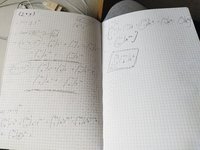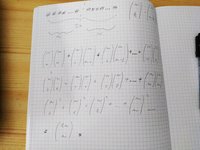You are using an out of date browser. It may not display this or other websites correctly.
You should upgrade or use an alternative browser.
You should upgrade or use an alternative browser.
sum equals to...? - III
- Thread starter Alen0905
- Start date
Steven G
Elite Member
- Joined
- Dec 30, 2014
- Messages
- 14,603
What have tried? You really have to be trying something before you come here asking for help. If you have done work, that is great! Then you need to post your work.
Have you written out some terms on the left hand side? Maybe you can somehow end up with multiplying nC1 with nC1 and nC2 with nC2 etc and then the results will follow. Maybe you can do something that will separate (nCk)^2 into something helpful.
BTW, what I wrote above in my 1st paragraph is in the forum rules. I would really appreciate it if you follow those rules. Thank you.
Have you written out some terms on the left hand side? Maybe you can somehow end up with multiplying nC1 with nC1 and nC2 with nC2 etc and then the results will follow. Maybe you can do something that will separate (nCk)^2 into something helpful.
BTW, what I wrote above in my 1st paragraph is in the forum rules. I would really appreciate it if you follow those rules. Thank you.
This is a very natural, intuitive presentation of it for my way of thinking, although it seems more like a logical projection then a combinatorical proof...perhaps it is valid enough, binomial presentation seems a bit hardcore to think of it in an exam.
Attachments
Steven G
Elite Member
- Joined
- Dec 30, 2014
- Messages
- 14,603
In the next to the last line at the very right are there there dots? If yes, then why?
(assuming no three dots at the end) what you wrote is fine, that is there are no errors until the last line. Why does what you wrote equal 2nCn? That is what you want to prove!
(assuming no three dots at the end) what you wrote is fine, that is there are no errors until the last line. Why does what you wrote equal 2nCn? That is what you want to prove!
Steven G
Elite Member
- Joined
- Dec 30, 2014
- Messages
- 14,603
If you put equal signs then maybe I could follow your work better. It is hard to see if two line are equal or they are just one expression that took two lines to write. I will look again at your work now I now there are in fact three dots.
Steven G
Elite Member
- Joined
- Dec 30, 2014
- Messages
- 14,603
The third to the last line ends, that is no three dots. You noticed that each term is being squared by writing that in the next line. But what is that line not ending at (nCn)^2? Why does it continue for ever and most importantly why does it equal that last line?
Steven G
Elite Member
- Joined
- Dec 30, 2014
- Messages
- 14,603
Looking at it again it is obvious that each line is meant to equal the next line but still you should write ie, especially if you have a mistake!Im sorry, that was a bit careless indeed
- Joined
- Nov 24, 2012
- Messages
- 3,021
Let's begin with:
[MATH](x+1)^n(1+x)^n=(x+1)^{2n}[/MATH]
Use the binomial theorem on each binomial...what do you get?
Using the binomial theorem, we get:
[MATH]\left(\sum_{k=0}^n\left({n \choose k}x^{n-k}\right)\right)\left(\sum_{k=0}^n\left({n \choose k}x^{k}\right)\right)=\sum_{k=0}^{2n}\left({2n \choose k}x^{2n-k}\right)[/MATH]
To make things a bit easier to see, let's rewrite the LHS as:
[MATH]\left({n \choose 0}x^{n}+{n \choose 1}x^{n-1}+\cdots+{n \choose n-1}x^{1}+{n \choose n}x^{0}\right)\left({n \choose 0}x^{0}+{n \choose 1}x^{1}+\cdots+{n \choose n-1}x^{n-1}+{n \choose n}x^{n}\right)[/MATH]
Now, we can easily see that on the LHS, we will have the term:
[MATH]\sum_{k=0}^n\left({n \choose k}^2\right)x^n[/MATH]
And on the RHS of the equation, we have the term:
[MATH]{2n \choose n}x^n[/MATH]
Hence, the following must be true:
[MATH]\sum_{k=0}^n\left({n \choose k}^2\right)={2n \choose n}[/MATH]



